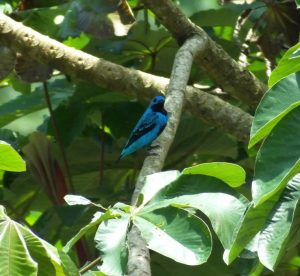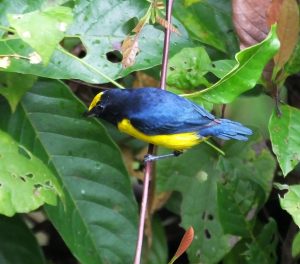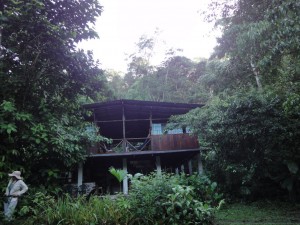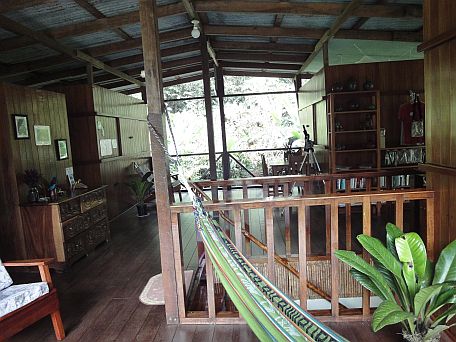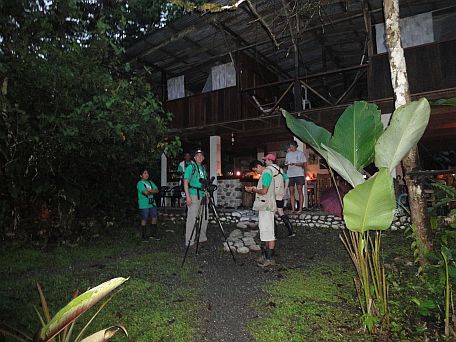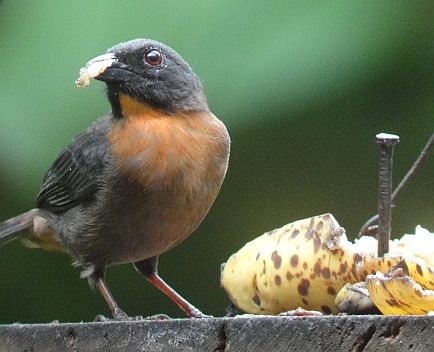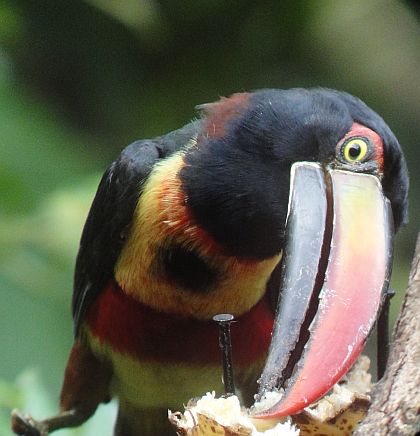Last week, I did a trip to Luna Lodge, one of the more remote ecolodges in Costa Rica, and one of the only ones that provides access to the interior forests of the Osa Peninsula. As befits any lodge in the heart of quality rainforest, the birding at Luna is always exciting. Upon arrival, you wonder if an extra large eagle might appear in the spotting scope while patiently scanning the canopy of a forested hillside. You wonder if the calls of a rare Red-throated Caracara will be heard echoing through the humid jungles. I personally wonder if I will finally glimpse a Puma while hiking through the rainforest. With the lodge surrounded on all sides by forest that extends into the heart of one of Costa Rica’s wildest areas, it truly seems like anything is possible. Although there haven’t been any recently documented sightings of Harpy or Crested Eagles in the Osa, and Pumas are around but always expert at staying hidden, Luna Lodge and nearby areas would be one of the better places for sightings like these to happen. This is, after all, rough, rugged rainforest where monkeys are heard and seen throughout the day along with lots of birds.
Check out them jungles…
and monkeys.
While they are still fresh in my mind, I present some highlights and observations from the trip:
A long drive: Driving from the Central Valley to Luna Lodge is an all day event. It takes around 8 hours to get there from the San Jose area and that doesn’t take into account any birding stops. Include birding en route and it takes a whole while longer to get there. Since the birding en route is very much recommended, you are better off not driving straight from San Jose but stopping for a night on the way. That, or just take a short flight to Puerto Jimenez or Carate (even more recommended!) and go from there. Although paved roads have made the trip far easier than in the past, you still have around 40 kilometers of rough, pot-holed, un-paved roads to drive over along with a few river crossings thrown in for good measure. That said, that section of the road also has some of the more exciting birding opportunities, and it would be worth it to slowly bird it from Puerto Jimenez.
Tarcoles: A small seaside settlement where the biggest attraction is a river with a high population of crocodiles might not be everyone’s cup of tea, but it sure is good for birding! We stopped there to check seasonal wetlands for whatever and the river mouth for shorebirds, terns, and other things with webbed feet. As usual the morning birding between Tarcoles and Playa Azul was nice and punctuated by Mangrove Vireo, Crane Hawk, Scarlet Macaws, and other species. Nothing unusual in the wetlands, nor on the beach, but always birdy. The best on the beach was probably Collared Plover.
The pink feet of a Wood Stork were a close second.
Dominical: Once you reach Dominical, you have the temptation to stop and bird side roads that access good rainforest, or even look for stuff from a gas station. We did that with the hopes of seeing Spot-fronted Swift. As luck would have it, we did almost certainly see them but with the frustration of not seeing or hearing anything absolutely diagnostic because of uncooperative lighting and distance from the birds. This means that we did see a flock of swifts that, by shape and flight pattern, were not Costa Rican, Lesser Swallow-tailed, White-collared, or Chestnut-collared. Since Spot-fronted are seen here regularly, there was a 99% chance that this is what they were. BUT, since the very similar White-chinned Swift has been found near there, even though it is far less likely, that still leaves enough room to cast some doubt on the birds being Spot-fronted Swifts. If only they would have flown a bit lower!
Rice fields: These pseudo wetlands are en route and if they have water, can have some nice birds. Check enough of them and you might even find Spotted Rail, Paint-billed Crake, and Slate-colored Seedeater. We didn’t find those with the brief checks we allotted but we did see lots of Black-bellied Whistling Ducks, Southern Lapwing, and a small flock of Shiny Cowbirds. They are also always worth checking to see if you can find a lost Wattled Jacana for your Cosa Rican list.
Cuisine: The food at Luna Lodge is fantastic. So good. Creative, delicious, healthy dishes that use several ingredients right from their organic garden. Enjoy dining amidst the sounds of the rainforest.
Rooms: Comfortable, peaceful, and with views into treetops that can have Turquoise Cotinga.
Turquoise Cotinga: Speaking of this one, it is fairly common at Luna Lodge and hard to miss. We had excellent views of males and females from the birding platform, from the rooms, and from a site near Luna Lodge (the hip sounding “Shady Lane”).
Good morning starshine, I mean shiny blue and purple bird!
Trogons, honeycreepers, and other cool tropical birds: Being situated in the middle of rainforest, one does tend to see quite a few birds, many of which are rather exotic in appearance. Bird the lodge grounds and the trails and you might see four trogon species, Shining and Green Honeycreepers, euphonias (think colorful little tropical goldfinches), Rufous Piha, Blue-crowned, Red-capped, and Orange-collared Manakins (all pretty common), and Golden-naped Woodpecker among other species. You can also try for the endemic Black-cheeked Ant-Tanager, Marbled Wood-Quail, and other deep forest species on the trails but be ready for hiking some fairly steep slopes (at least on maintained trails).
Spot-crowned Euphonia is a common endemic.
Same goes for the beautiful Golden-naped Woodpecker. It’s kind of like a Three-toed Woodpecker that went to the beauty salon.
Rufous Piha was pretty common right at the lodge.
Raptors: Yeah, we dipped on all eagles, even the hawk ones. But, we still saw 18 species of raptors, some on the ride to the lodge, and some right at the lodge. On the way there, we had the aforementioned Crane Hawk, Turkey and Black Vultures, Yellow-headed and Crested Caracaras, Roadside Hawks aplenty, White-tailed Kite, Common Black Hawk, Zone-tailed Hawk, and Bat Falcon. At Luna Lodge, mostly during a morning of raptor watching from the yoga platform (don’t you know that yoga platforms are always conducive with good raptor watching?), we also had White Hawk- a common, beautiful species in the area, Short-tailed Hawk, Great Black Hawk- nice to see that rare one, King Vultures, and Swallow-tailed and Double-toothed Kites. Collared Forest-Falcon was a heard only, and our last raptor was Laughing Falcon on the drive out.
Shady Lane: I love birding a place with a name like that! It would also be cool to bird it while wearing a bowler hat and walking with a Victorian style cane in one hand and a cold mojito in the other. The only problem would be that unwelcome extra bit of heat generated by the hat in 90 degree humid air, and dropping the cane while juggling the drink as you grab your binos time after time in that birdy spot. Actually, it was a bit slow during our morning visit. We still managed three trogon species (including Baird’s), Bicolored Antbird, Tawny-winged, Cocoa, and Northern Barred Woodcreepers, Turquoise Cotinga, White Hawk, King Vulture, Red-capped and Blue-crowned Manakins, Golden-crowned Spadebill, and other species (including three heard only too shy Streak-chested Antpittas), but the spot can be even birdier than that! Try as we might nor did we find a super rare Speckled Mourner but it was still a fine morning at Shady Lane.
Climate change: Now for something not as happy but deserving of mention. We got rained out each afternoon and that was a good thing because the forests of the Osa have been experiencing much less rain than they are adapted to. Lower amounts of rainfall in the Osa are because of global warming and this is almost certainly why we did not detect as many individual birds or species compared to 16 years ago. The differences are noticeable every time I go birding anywhere in Costa Rica, and anyone who has been birding here for more than ten years probably sees these changes as well. There hasn’t been any deforestation around Luna Lodge, and if anything, more forest in growing but there has been less rain and no, it’s not some natural cycle.
Why do I say that? Because I believe everything I hear? No, I say it because thousands of peer-reviewed papers come to that conclusion. If you don’t believe in human-caused global warming, then I suggest that you please be objective and consider these two options: 1.Human caused global warming is real because scientists who fiercely compete with each other over grant money and funding, publish thousands of peer-reviewed papers that indicate this to be the case, or 2. Human caused global warming is false because this is claimed in non-peer reviewed information distributed by organizations paid to do so by the fossil fuel industry. Which seems more likely? If you choose “2”, then you might as well not trust anything any medical doctor says (because they rely on peer-reviewed scientific studies) or believe that the moon is real. Although this might seem tangential, when it comes to bird populations (as well as the future of human civilization and possibly existence), mentioning global warming is all too relevant. I wish it wasn’t, but diminishing bird populations say otherwise. Please plant a tree and work for sustainable, non-fossil fuel energy now!
I don’t like to end that on an alarming note but as my friend Brad used to say, “That’s the way the ball bounces Little P”.
Ok, well, I will end it on a more positive note after all. Lana Wedmore, the owner of Luna Lodge told us that a sustainable public school will be built in Carate! Instead of kids having to travel several kilometers to school, they can learn right there at the start of Shady Lane. Also, she is selling really cool White Hawk shirts for what else but the White Hawk Foundation- http://www.whitehawkfoundation.org/. The goal of this foundation is to purchase forested lands between Corcovado Park and Luna Lodge to keep them protected. Please check out the link to see the White Hawk video, information, and how to purchase some of those shirts.
Lana shows the White Hawk shirt.




